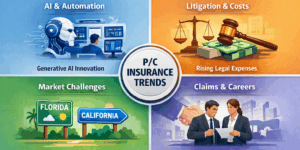When two InsurTech watchers tallied up underwriting results for Lemonade recently to conclude that the company’s annual “Giveback” to policyholders’ selected charities might shrink in coming years, Lemonade’s CEO offered words of disagreement on social media.
“Lemonade’s Giveback is one of the company’s most intriguing features. Customers join cohorts, and if any premium remains after paying the cohort’s claims, fees, and reinsurance, that money goes to a designated charity,” wrote Matteo Carbone and Adrian Jones, in an article published on Carrier Management and other publications recently.
“Lemonade has hinted at “an exponentially larger giveback in years to come.” We’re not so sure,” the two authors continued, pointing to high loss ratios which would prompt external reinsurers to increase reinsurance costs, and to a recent hike in a flat fee for services paid by Lemonade Insurance Company to parent Lemonade Inc. out of the insurance company’s premium revenue—both of which could seemingly cut into the Giveback slice of the overall premium pie.
Taking to LinkedIn, where Carbone and Jones first published their “Bigger and Redder” article about the first-quarter results of Lemonade, Root and Metromile, Daniel Schreiber, the chief executive of Lemonade, did not refute the fact the early underwriting results for his behavioral science and artificial intelligence company are not quite in the pink, but stated that early loss ratios in excess of 100 across the company will not impact the ability to pay out a Giveback to all cohorts. And “the flat fee between the companies has zero impact on the Giveback,” he wrote, noting that the Giveback formula has “remained unchanged since before we launched.”

“It’s appropriate to highlight our loss ratio (though a little bemusing when industry insiders, who presumably understand the impact of data-paucity in the early quarters, and the fact that a loss ratio is a lagging indicator, derive doomsday conclusions from a loss ratio over such a short period, this early in the game),” wrote Schreiber in his LinkedIn comment. “The loss ratio does impact the Giveback (on a cohort by cohort basis, so as was the case last year, a Giveback can result from pockets of good loss ratios even if the book, overall, has high losses),” he wrote.
For 2017-2018, the actual answer will come soon enough, with Giveback amounts scheduled to be calculated and paid at the end of June. Last year, in early July, Lemonade said that the “Giveback” was 10 percent of “revenues Lemonade recognized” from its launch in 2016 until mid-2017.
“The Giveback will probably remain—someone’s cohort will have very low losses—but the combined effects of a bigger fee to the parent and more expensive reinsurance could greatly reduce the Giveback ‘in years to come,'” Carbone and Jones wrote in their article. They went on to note that Lemonade has lots of cash to weather some years of poor results and that they are “cheering for” all three InsurTechs, expecting to see rapid growth and some profitability improvements for the trio in quarters to come.
Simple As Pie

On LinkedIn, Carbone’ tone was more skeptical—”cynical,” by Schreiber’s estimation—as the two exchanged comments. In several comments, Carbone referred to the determination of a component of the Giveback formula—40 percent of premium available for charitable distribution when there are no claims for a cohort—as part of a “shell game.” Drawing attention to a simplified pizza pie illustration that explains the calculations to consumers on Lemonade’s website, Carbone argued that Lemonade has not been transparent enough about the Giveback calculation or the flat fee.
A version of the pizza pie illustration shown on the bottom of Lemonade’s homepage, first depicts a pizza with five slices—one shaded pink depicting “A flat fee to run everything.” Alongside that, a pizza with four of the five slices shaded in pink is captioned, “We pay claims super fast.” And to the right of that, the image of a slice of pie and a glass of Lemonade are presented with the caption, “If there’s money left over, we give it back to causes.”
For his part, Schreiber, explained that “the Giveback formula is really simple: up to 40 percent of earned premiums per cohort is paid to the cohort’s charity—depending on the cohort’s loss experience. And it hasn’t changed. The pizza diagram is an abstraction (clearly), but it holds true. Any underwriting profits per cohort (up to 40 percent—a limit set by regulators) are donated to the group’s cause.”
Schreiber kept the explanation short. “[I]n my experience it means that my continuing to explain or answer is unlikely to be productive,” he wrote, after taking note of the cynical tone of Carbone’s LinkedIn comments, which Carbone punctuated with the use of smiling devil and angel emojis.

Baiting Schreiber once more, Carbone contrasted the 40 percent figure available for both claims and Givebacks with a typical homeowners insurer loss ratio of 50, and Jones honed in on Lemonade’s promise of transparency. “Lemonade has challenged the insurance community to be curious by criticizing the industry and saying they’ll do better and will be transparent about it. Following the early Transparency blogs, I thought we might see yellow books on the Transparency blog, along with explanations for how the business is evolving and why,” Jones wrote, referring to yellow statutory financials filed with regulators. “The exchange in the comments immediately above [between Carbone and Schreiber] reflects the disconnect between the public explanations (which have to be somewhat simplified) and the complexities of insurance,” he wrote.
The comments drew one last response from Schreiber, who also explained varying levels of disclosure depending on the level of interest of the audience. “Messaging is a balance between simplification (=comprehensible but inaccurate) and comprehensiveness (=accurate but accessible to a tiny subgroup). We try to straddle this by giving abstractions (like the Pizza) for those who want just a headline, and FAQs and blog posts for those who will take the time to understand the details. This isn’t a lack of transparency, it’s the result of a thoughtful attempt to be as transparent as possible,” he wrote in part of his response. His comment included an external link to one of his blog posts from March 2017, “Why I Tied My Hands,” which explains the reason for the flat fee. In short, it’s a structural fix to a conflict of interest between insurers and insureds that has insurers disincentivized to pay claims fairly.
The Fee: Tying Executives’ Hands to Assure Fair Claims Payouts
Carrier Management reached out to Schreiber to offer space to write an article for our website responding to Carbone and Jones on a forum other than social media. Unable to do so in the middle of a busy travel schedule, Schreiber referred us to Lemonade’s head of communications, who offered a brief statement. “Contrary to what the authors wrote, the change in structure between the companies has zero impact on our social good program, the Lemonade Giveback, which has remained unchanged since before we launched,” she wrote.
Beyond that, we have excerpted below, some of information about the flat fee paid by Lemonade Insurance Company to Lemonade Inc. and about the Giveback calculation from different parts of the company’s website and blog posts.
 In his “Why I Tied My Hands” blog post, Schreiber explains the flat fee by referencing a tale about Ulysses, who bound his hands to avoid temptation. In the case of Lemonade, the temptation is the inclination to avoid paying claims. “I run an insurance company, and I’m tempted to deny your claims. You see, every dollar I don’t pay you, is a dollar more to our profits,” he writes, introducing the idea that every insurance company leader—virtuous or not—is tempted in this way because of the way insurance is structured.
In his “Why I Tied My Hands” blog post, Schreiber explains the flat fee by referencing a tale about Ulysses, who bound his hands to avoid temptation. In the case of Lemonade, the temptation is the inclination to avoid paying claims. “I run an insurance company, and I’m tempted to deny your claims. You see, every dollar I don’t pay you, is a dollar more to our profits,” he writes, introducing the idea that every insurance company leader—virtuous or not—is tempted in this way because of the way insurance is structured.
But by simply deciding to take a specified portion of every premium dollar collected upfront, treating the rest as beyond the company’s reach, the temptation to underpay claims is avoided. “It’s not our money,” he writes.
“Insurers typically make money by investing premiums (“float”) or by paying out less in claims and expenses than they took in premiums (“underwriting profit”). Lemonade relies on neither. We collect premiums monthly, so the money earns interest in your bank account, not ours, and we return unclaimed money at year’s end in Lemonade’s Giveback.”
Speaking at the Silicon Valley Insurance Accelerator’s Core Systems and InsurTech FUSION in late March 2017, Schreiber gave these details, also explaining how the Lemonade structure limits policyholder temptations to submit fraudulent claims, frees Lemonade to provide a positive experience for claimants, and the role of reinsurers in the mix:
“We take a 20 percent fee. We say you give us your $1,000 premium. $200 of that is going to us. Never more, never less, which is an unorthodox thing for an insurance company to say.”
[That] is why if you’re embellishing claims, you’re not hurting us, you’re hurting that charity. And if there are insufficient funds, we have a panel of reinsurance partners to whom we pay in every year to take care of that excess when it should occur.
“So, the reinsurer will pay that excess. Lemonade is not conflicted—at least a first approximation, we are indifferent to whether or not you make a claim….Now, the system has to work. That’s not true ultimately but it’s true at first approximation. That changes a great deal.
“So, we take our 20 percent, we pay claims and we give back what’s left….
“That allows us to do things very differently on the artificial intelligence and on the tech side.
“If I am in the business of trying to be very careful not to pay claims when I can get away with it, then I have an incentive to throw paperwork and process at you to make the claims process a cumbersome process. [In contrast], we’ve paid many claims is literally a second or two—actually three seconds, to be honest, is our record.”
(Editor’s Note: According to Carbone and Jones, the fee is actually 25 percent today. But since the substance of the Schreiber’s argument above—that “unclaimed money” does not belong to the carrier— remains intact, we have republished it here.)
Digging for Giveback Details
 Trying to understand Schreiber’s assertion that an increase the percentage of premium taken for the hand-tying fee will not in any way impact the Giveback, it’s necessary to dig deeper into how the remainder of each premium dollar is used.
Trying to understand Schreiber’s assertion that an increase the percentage of premium taken for the hand-tying fee will not in any way impact the Giveback, it’s necessary to dig deeper into how the remainder of each premium dollar is used.
As Schreiber noted in his LinkedIn comments, explanations of the Giveback range from the simplified pizza pie diagram to more technical and legal, depending on where you look for the information.
One step more complex than the pie chart, for example, is a response to the question, “How are you using my premium dollars?” among frequently asked customer questions. Here, Lemonade explains that premium not used to pay claims or for Giveback money is split among three buckets—the flat fee, paying for external reinsurance and paying into a fund of internal reinsurance.
Because external reinsurance is costly, “our data scientists have modeled an optimal mix of internal funding and external reinsurance, and we set aside another ~20 percent as our ‘rainy day fund,'” the response explains.
After noting that some smaller expenses, like premium taxes, are paid “from the part of the premiums that go to this combination of reinsurance and our rainy day fund,” the answer highlights the important chunk of premiums—the Giveback. “After these three things”—the fixed fee, external reinsurance and the “rainy day fund”—”our data scientists estimate that up to 40 percent of premiums will be available to Giveback to causes our policyholders care about each year.
“Of course, there will be claims, so the amount available will average less than 40 percent,” the answer continues, noting that if claims come in more than 40 percent, there will be no Giveback. “Fear not. Both we [Lemonade] and our reinsurers have set aside funds for exactly such a situation.”
(Editor’s Note: Putting together the increase in the flat fee and Lemonade’s assertion that this has no impact on the Giveback, one possible conclusion is that there will be an impact on internal or external reinsurance, the only pie pieces left.)
In a section of the website devoted to “Legal Stuff & Reinsurance,” under a subsection titled, “A Guide to Giveback,” Lemonade notes the role of the insurance company’s board of directors, which must exercise a duty of care in authorizing Giveback payments. Here, again, the discussion reviews the three non-Giveback, non-claims uses of premium dollars—20 percent deducted for the expenses of running the business, “some premiums” to buy outside reinsurance, and roughly 20 percent for a rainy day fund, premium taxes and other transaction fees—collectively referring to the last piece as “our very own Lemonade Reinsurance.”
Investor Questions
Beyond the FAQs for consumers, Jones posed some overarching questions for Lemonade and all other InsurTech carrier startups that will be answered in the years ahead in one of his comments on LinkedIn.
“The question for [all of them] is whether they can find a business model that provides enough premium and investment income to fund prices that may be below market, ordinary losses, catastrophes (reinsurance), expenses, acquisition costs, a great UX, awesome claims handling, and a charity giveback.
“In the first few years, the answer is almost certainly not. But difficulties are to be expected, and investors will be patient.
“Can the company continue in the long term to give back 10 percent of revenues and provide an adequate return to their capital providers? As Matteo [Carbone] alludes to, Daniel [Schreiber] and team will have built one of highest-performing companies in the renters/HO industry if they can make this equation work,” Jones wrote.





















 Why the Middle Market Matters and How Insurers Can Capture It
Why the Middle Market Matters and How Insurers Can Capture It  How Insurers Can Avoid Post-Merger Technology Failure
How Insurers Can Avoid Post-Merger Technology Failure  Howden US Tells Judge Brown & Brown Employees Fled Due to ‘Mistreatment’
Howden US Tells Judge Brown & Brown Employees Fled Due to ‘Mistreatment’  Market Softening Accelerates During 1/1/2026 Re Renewals
Market Softening Accelerates During 1/1/2026 Re Renewals 





